Mon, Jun 18, 2012
Alion Wins $1.2M NASA Contract To Develop Scenario-Based Models Of Astronaut Performance And Conduct Human Studies
During human space missions, the crew and ground personnel must function under high stress and workload, often with disrupted sleep patterns. Astronauts sometimes suffer from sleep deprivation during long spaceflight missions, which could potentially have an adverse effect on performance. Alion Science and Technology, an employee-owned, engineering, R&D, IT and operational solutions company, was awarded a $1.2 million contract from the National Aeronautics and Space Administration (NASA) to develop a model-based software tool to predict the effects of astronaut fatigue on performance, particularly during workload transitions.

Under the three-year Space Performance Research Integration Tool (S-PRINT) project, Alion will develop human performance models to predict astronaut performance in various automation failure situations. Although long-duration spaceflights include highly automated systems, astronauts need to remain alert, particularly during a potential automation failure situation. In such a worst-case scenario, fatigue, complacency due to over-reliance on automation, and sudden workload transitions could create a challenging spaceflight mission.
Alion’s work consists of three phases: a literature review and meta-analyses phase for gathering data and quantifying long-duration mission effects on performance; model and tool development; and human-in-the-loop studies to evaluate and refine model predictions and address gaps identified in the meta-analyses. The human-in-the-loop studies will be conducted at Colorado State University.
“Alion’s human performance models will help NASA enhance astronaut performance by predicting the effects of fatigue on performance during automation mode transitions,” said Terri Spoonhour, Alion Senior Vice President and Manager of the Distributed Simulation Group. “S-PRINT will provide NASA with a method to evaluate and compare the effects of potential countermeasures to maintain optimal astronaut performance in long-duration space missions.”
The contract runs until March 31, 2015.
More News
Takeoff Roll The process whereby an aircraft is aligned with the runway centerline and the aircraft is moving with the intent to take off. For helicopters, this pertains to the act>[...]
“We’re proud of the hard work that went into receiving this validation, and it will be a welcome relief to our customers in the European Union. We couldn’t be mor>[...]
"Aircraft Spruce is pleased to announce the acquisition of the parts distribution operations of Wag-Aero. Wag-Aero was founded in the 1960’s by Dick and Bobbie Wagner in the >[...]
IDENT Feature The special feature in the Air Traffic Control Radar Beacon System (ATCRBS) equipment. It is used to immediately distinguish one displayed beacon target from other be>[...]
Aero Linx: Pararescue Air Force Pararescuemen, also known as PJs, are the only DoD elite combat forces specifically organized, trained, equipped, and postured to conduct full spect>[...]
 ANN's Daily Aero-Term (05.10.24): Takeoff Roll
ANN's Daily Aero-Term (05.10.24): Takeoff Roll Aero-News: Quote of the Day (05.10.24)
Aero-News: Quote of the Day (05.10.24) Aero-News: Quote of the Day (05.11.24)
Aero-News: Quote of the Day (05.11.24) ANN's Daily Aero-Term (05.11.24): IDENT Feature
ANN's Daily Aero-Term (05.11.24): IDENT Feature ANN's Daily Aero-Linx (05.11.24)
ANN's Daily Aero-Linx (05.11.24)



